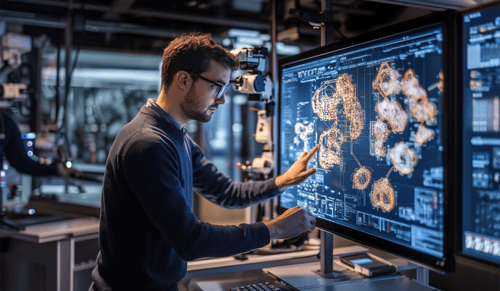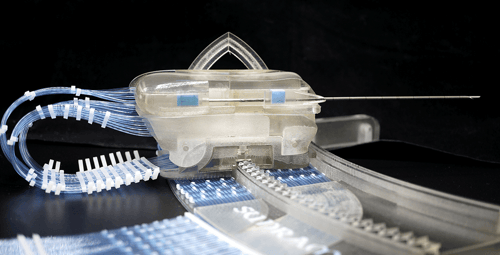What will a healthy food system look like in 2050?
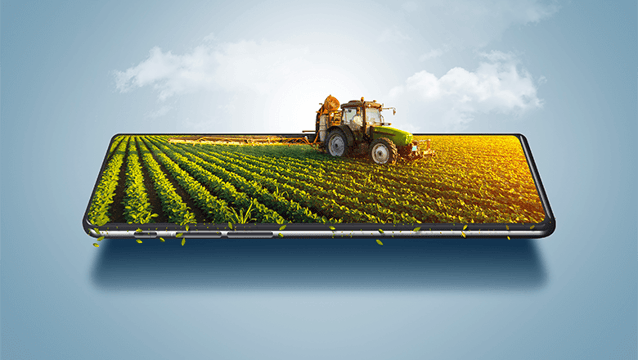
Our food production is in need of a thorough upgrade. The focus must change: from more to better, and to more sustainable. We must learn to deal with Earth's limitations. What does sustainable food production look like? How can we achieve such a food system? And which technologies do we need to do so?
Together with Wageningen University & Research (WUR) professor Imke de Boer, the technology industry association FME drafted a vision report that defined the design principle for the future food system as well as the technology to make it possible. Co-initiator Marcel van Haren adds, ‘The important thing is to start quickly.’’
The Netherlands as agricultural exporter
In 2020, the Netherlands was the world's second largest agricultural exporter and third largest AgriFoodTech exporter. That year, the Dutch exported 105.5 billion euros of agricultural (and related) goods. To be honest, that is only about one-third of what enters our country via the Port of Rotterdam. But, still, what remains is a sector that we can be proud of.
The good news? An important part of that export consists of tertiary agricultural goods. Examples of these are agricultural machinery, food production machines, and greenhouse materials. The added value of these goods is considerably higher than that of food. This line of work was good for almost 10 billion euros in 2020, and it's growing fast.
‘Technology for greenhouse horticulture is booming, for example,’ says Marcel van Haren, until recently the Agriculture, Water & Food program manager at FME and, since September, Specialist Lobbying & Public Affairs manager at ZLTO, a regional association of farmers and growers.
‘Some companies no longer have a clue as to how they will get all their deliveries. And that's not only due to a shortage of parts; it's also because of the enormously high demand.’ The Netherlands has a good starting position, Van Haren believes. ‘There is certainly nothing wrong with the business case.’
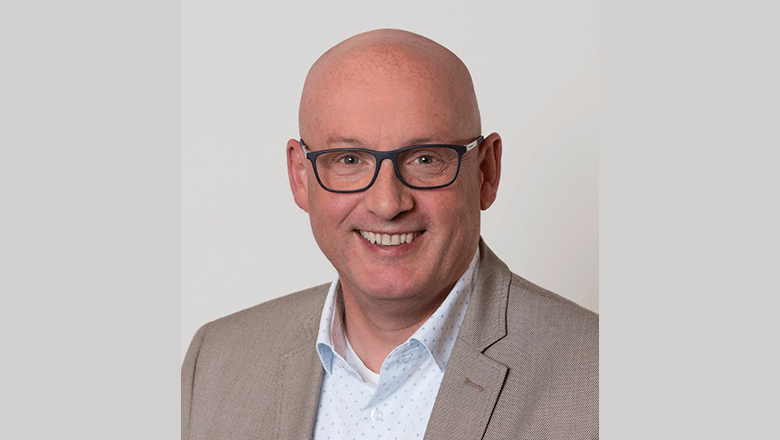
Marcel van Haren, Specialist Lobbying & Public Affairs manager at ZLTO
Reliance on technology
The Netherlands is the global market leader in milking robots, greenhouse horticulture machines and production systems, meat-processing machinery, and packaging lines for the fresh-food market, among other markets. ‘In terms of greenhouses, potatoes, meat and milk, for example, all eyes are on us,’ Van Haren says knowingly. ‘And that is fantastic, of course, but it also brings responsibility.’
After all, Van Haren believes that we must realize one thing: ‘Over the past two hundred years, technology has ensured that the food supply has demonstrably improved people's lives. Due to recent national and provincial policy, however, the developments in the agricultural sector threaten to bring progress to a standstill. We must make extra investments in this area in the coming period. Even though we have done all of this with the best of intentions, we must now recognize that there are limits to what the Earth can take.’
Paradigm shift in design
Fortunately, change has been visible for about ten to fifteen years. The focus is more often on sustainable and circular agriculture and production, more attention is being given to nutritional value, it is increasingly more obvious where the products you buy come from, the chains are becoming shorter, and there is less waste.
‘It remains important that we incorporate past lessons learned when we think about how we want to shape the food system in the future,’ says Van Haren. He argues that a paradigm shift is necessary to bring that about.
‘We must re-design the technology for our food production — so that it acts as a good steward for the total earthly ecosystem. That means working with nature, with people no longer the designer of nature but a part of it.’
Preferably yesterday than today
Unfortunately, the current technology is not always designed in this way. Now it is often focused on doing everything as efficiently as possible. And that's why it's often done on a large scale. ‘We already call something sustainable if we put a few solar cells on it, but naturally it's not that easy,’ Van Haren laughs, before immediately becoming serious.
‘I think that we are already much too late. That's not to say that you can't do anything, but that we must proceed very quickly. The agricultural sector wants to proactively collaborate to reduce nitrogen and methane emissions and improve the soil and water quality. Above all, let's create space to fully utilize the strength of the AgriFoodTech entrepreneurs.’
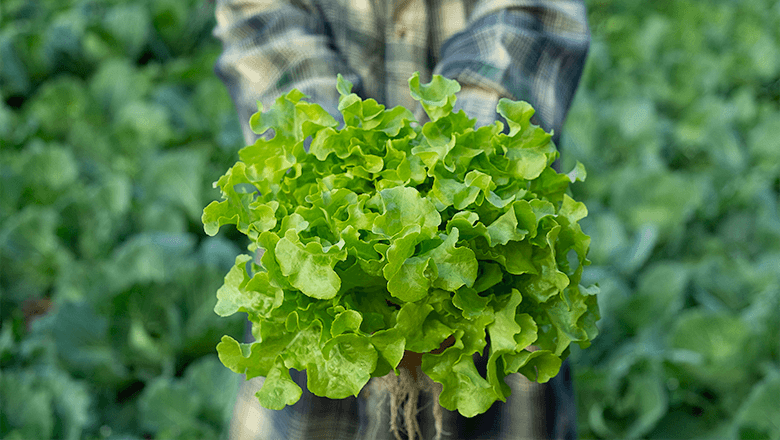
What does a healthy food system look like?
What should the food system of the future look like, technology industry association FME asked itself. ‘We quickly settled on the work of WUR Professor Imke de Boer,’ says Van Haren.
De Boer, professor of Animal Production Systems, won the Rockefeller Foundation's 2020 Food Systems Vision Prize for her vision of a regenerative and healthy food system in 2050 and the changes that are needed to achieve that.
‘Her inclusive view of food, based on healthy agro-ecosystems that supply healthy products, is — according to her and according to us — the best possible approach at this time. An ability to make adjustments is important because things that require us to reconsider it will undoubtedly soon cross our path. The main point is not to leave it all to discussion but to just start.’
Example of sustainable food production
A key step is to work on a much smaller scale and in a more varied manner, by planting all sorts of crops next to and mixed with each other on the land. A good example of sustainable food production is strip cropping, where different crops are grown in strips next to each other.
‘The yield is then 20 to 25 percent higher, and you can achieve that with virtually no herbicides because the crops help and protect each other. Nature sure devised that well,’ says Van Haren. ‘It does require some more labor but, in practice, that turns out to be better than expected. Of course, automation is needed because there is and continues to be a shortage of personnel. This requires flexible technology.’
Flexible technology required
Van Haren sees that there is a great deal of interesting technology just waiting to be put to work. ‘Knowledge institutions and companies have already solved many issues or have technology available that does it many times better than what we have now. Only, it is scarcely applied. So let's start with that: try, learn and improve. Make mistakes but experiment,’ he advises.
He gives apple picking as an example. ‘There is available sensor technology that gives an apple farmer much more information about which apples are ripe and where the farmer should deploy their workers, but also where a disease is rearing its head so that the farmer can combat it in a very focused manner.’

Plans such as strip cropping, urban farming or food forests cannot be solved with large-scale mechanization. ‘We need good models of all these environments — of the field, greenhouse, stall, factory — so that we can automate and robotize appropriately. This starts with the collection of data via sensors and cameras so we, via machine learning and artificial intelligence, can prepare the robots and machines for the flexibility that is needed,’ explains Van Haren.
Technology is not a goal but a means
The design principle around which everything revolves is that we will work according to ecological logic and based on (regional) cycles. Not only for the production itself but also for the technology that we deploy for it. ‘If you create a robot full of rare earth elements that are mined on the other side of the world under appalling circumstances, you have probably not found the best solution — even if such a system is very economical and effective,’ according to Van Haren.
‘Designers must treat their systems for sustainability, biodiversity, circularity, health, labor, CSR,’ he continues. ‘I consciously don't call it solve, because it is a continuous process. What's more, the technology must offer added value in three areas: value for nature, for society, and for the customer. Only then does it have real meaning. Because technology is not a goal but a means.’
Sensors make the difference
Naturally, Van Haren does not escape without a question about the nitrogen crisis. Does he think that (sensor) technology can offer a solution there? ‘Technology can certainly contribute but it will not solve everything,’ Van Haren answers.
‘Because of the large quantity of livestock, there is a surplus of ammonia. Technology can provide solutions for that. But nitrogen is not the only problem. For example, there are also phosphates that are leached into the groundwater. Other innovations are needed there. Among other uses, sensors can help to clarify the emissions. This offers the opportunity to reward farmers who perform well.’
Van Haren sees another interesting application for sensors. ‘Soon, plant protection products may practically no longer be used, which will make weed control quite a bit more complex. The early recognition of weeds, but also of diseases and plagues, is necessary so that timely actions can be taken. Sensors can prevent escalations.’
Which technologies are suitable for the agricultural sector?
Developments in the agricultural sector are occurring at a rapid rate. You as an OEM are therefore searching for an end product that can be integrated immediately, that is watertight, and that can withstand significant contamination. Now, that's convenient, because we have listed them here for you.
Discover the most important 5 sensor technologies for the agricultural sector.



